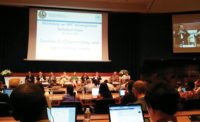If it sometimes seems confusing and difficult to identify and keep track of the various treaties and regulations that are having an effect on the refrigerants industry, that’s because it is. Here is a brief primer.
The Montreal Protocol on Substances that Deplete the Ozone Layeris an international treaty designed to protect the ozone layer by phasing out the production of substances that are responsible forozone depletion. It was agreed to in 1987, and entered into force January 1, 1989. It has been through a number of revisions since then: if an agreement is reached in Dubai this year, it will be the ninth. The Montreal Protocol has been responsible for the phaseouts and bans on chloroflourocarbons (CFCs) and hydrochlorofluorcarbons (HCFCs).
The Kyoto Protocolis an international treaty that extends the 1992 United Nations Framework Convention on Climate Change (UNFCCC). It commits signatories to reduce greenhouse gas emissions that are suspected of contributing to climate change. It is the Kyoto Protocol that has already targeted hydroflurorcarbons (HFCs): although HFCs have zero ozone-depletion potential, they are considered greenhouse gases because of their global warming potential (GWP). Developed countries following the Kyoto Protocol report their HFC emission data to UNFCCC.
The Significant New Alternatives Policy (SNAP) Program is EPA’s program to evaluate and regulate substitutes for the ozone-depleting chemicals that are being phased out under the stratospheric ozone protection provisions of the U.S. Clean Air Act. Recently, it has been used to propose a de-listing and phaseout of HFCs in certain applications, which some view as a step beyond its boundaries, as HFCs are not ozone-depleting.
President Obama’s Climate Action Plan. In effect since 2013, this plan targets reductions in greenhouse gas emissions, including carbon dioxide, which is one of the primary greenhouse gases in the Earth’s atmosphere. Its tenets include preserving forests, encouraging the use of alternate fuels, and increased study of climate change.







![695552959_ceec46c8c5_o[1].jpg The nations of the world have agreed to amend the Montreal Protocol in 2016 to reduce the production and consumption of HFCs globally.](https://www.achrnews.com/ext/resources/2015/11-2015/11-23-2015/695552959_ceec46c8c5_o1.jpg?height=200&t=1448043462&width=200)


